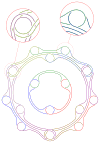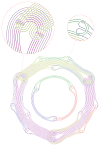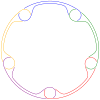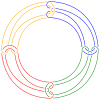Synthesising Topological Links
- PMID: 25678732
- PMCID: PMC4321808
- DOI: 10.1007/s10910-014-0420-3
Synthesising Topological Links
Abstract
We discuss the chemical synthesis of topological links, in particular higher order links which have the Brunnian property (namely that removal of any one component unlinks the entire system). Furthermore, we suggest how to obtain both two dimensional and three dimensional objects (surfaces and solids, respectively) which also have this Brunnian property.
Keywords: Brunnian links; Hopf links; Synthesizing double stranded DNA nodes; Synthetic DNA topology of links; carpets and solids.
Figures





















References
-
- Baas NA. New states of matter suggested by new topological structures. International Journal of General Systems. 2013;42(2):170–196.
-
- Baas NA. New structures in complex systems. European Physical Journal. 2009;178:25–44.
-
- Baas NA. On structure and organization: An organizing principle. International Journal of General Systems. 2013;42(2):170–196.
-
- The Knot Atlas. Rubber band links. http://katlas.org/wiki/“Rubberband”_Brunnian_Links.
Grants and funding
LinkOut - more resources
Full Text Sources
Other Literature Sources
